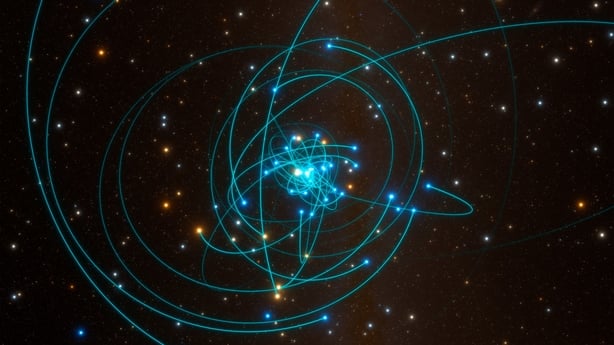Scientists have proven Albert Einstein's Theory of General Relativity by measuring the effects of a supermassive black hole on a star passing through its gravitational field.
It is the first time that the fundamental theory of physics has been verified in this way and marks an important step forward in our understanding of the laws of physics that govern the universe.
The significant discovery is the result of 26 years of observations using powerful telescopes in Chile owned and operated by the European Southern Observatory.
Einstein's 1916 theory says that gravity arises when enormous objects like the Earth and the Sun warp and distort the very fabric of space and time.
Over the years, the theory has been proven to be correct by a number of different experiments involving smaller objects close to Earth.
But scientists were keen to test whether the theory held under the most extreme conditions, like those around a supermassive black hole, where gravity is much stronger.
To do this they began studying Sagittarius A* (Sgr A*), the supermassive black hole 26,000 light years from Earth at the centre of our Milky Way galaxy, which contains the mass of 4 million suns.
Sgr A* is surrounded by a small group of stars, including S2 which orbits it once every 16 years.
Using the GRAVITY, SINFONI AND NACO instruments on the Very Large Telescope (VLT) at ESO's Paranal observatory in Chile, an international team of scientists monitored the path of S2 as it passed around Sgr A* in May.
Using extraordinarily precise measurements they found that at its closest point to the black hole, some 20 billion kilometres, S2's path veered slightly as it passed through the extreme gravitational field, the strongest in our galaxy.
In particular they observed what is known as "gravitational redshift" - the stretching of light coming from the star to longer wavelengths by the strong gravitational field.
The results are precisely consistent with the predictions of Einstein's theory, but do not tally with what would be expected by Newton's or others gravitational hypothesis.

"This is the second time that we have observed the close passage of S2 around the black hole in our galactic centre," said Reinhard Genzel of the Max Planck Institute for Extraterrestrial Physics who led the research.
"But this time, because of much improved instrumentation, we were able to observe the star with unprecedented resolution.
"We have been preparing intensely for this event over several years, as we wanted to make the most of this unique opportunity to observe general relativistic effects."
The discovery is important because it shows Einstein's landmark theory is consistent in even the most extreme environments in the universe and opens the door to further research.
"Here in the Solar System we can only test the laws of physics now and under certain circumstances," said Françoise Delplancke, head of the System Engineering Department at ESO.
"So it's very important in astronomy to also check that those laws are still valid where the gravitational fields are very much stronger."
After a long campaign by astronomers here, Ireland is set to join ESO in September of this year.
Membership will give Irish scientists access to research time using the VLT, the under construction European Extremely Large Telescope and ESO's many other instruments.







